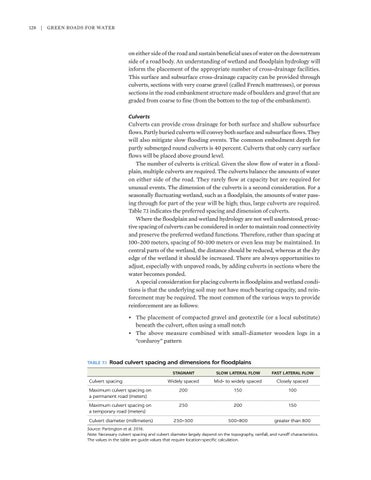128 | Green Roads for Water
on either side of the road and sustain beneficial uses of water on the downstream side of a road body. An understanding of wetland and floodplain hydrology will inform the placement of the appropriate number of cross-drainage facilities. This surface and subsurface cross-drainage capacity can be provided through culverts, sections with very coarse gravel (called French mattresses), or porous sections in the road embankment structure made of boulders and gravel that are graded from coarse to fine (from the bottom to the top of the embankment). Culverts
Culverts can provide cross drainage for both surface and shallow subsurface flows. Partly buried culverts will convey both surface and subsurface flows. They will also mitigate slow flooding events. The common embedment depth for partly submerged round culverts is 40 percent. Culverts that only carry surface flows will be placed above ground level. The number of culverts is critical. Given the slow flow of water in a floodplain, multiple culverts are required. The culverts balance the amounts of water on either side of the road. They rarely flow at capacity but are required for unusual events. The dimension of the culverts is a second consideration. For a seasonally fluctuating wetland, such as a floodplain, the amounts of water passing through for part of the year will be high; thus, large culverts are required. Table 7.1 indicates the preferred spacing and dimension of culverts. Where the floodplain and wetland hydrology are not well understood, proactive spacing of culverts can be considered in order to maintain road connectivity and preserve the preferred wetland functions. Therefore, rather than spacing at 100–200 meters, spacing of 50–100 meters or even less may be maintained. In central parts of the wetland, the distance should be reduced, whereas at the dry edge of the wetland it should be increased. There are always opportunities to adjust, especially with unpaved roads, by adding culverts in sections where the water becomes ponded. A special consideration for placing culverts in floodplains and wetland conditions is that the underlying soil may not have much bearing capacity, and reinforcement may be required. The most common of the various ways to provide reinforcement are as follows: • The placement of compacted gravel and geotextile (or a local substitute) beneath the culvert, often using a small notch • The above measure combined with small-diameter wooden logs in a “corduroy” pattern
TABLE 7.1 Road
culvert spacing and dimensions for floodplains STAGNANT
SLOW LATERAL FLOW
FAST LATERAL FLOW
Widely spaced
Mid- to widely spaced
Closely spaced
Maximum culvert spacing on a permanent road (meters)
200
150
100
Maximum culvert spacing on a temporary road (meters)
250
200
150
Culvert diameter (millimeters)
250–500
500–800
greater than 800
Culvert spacing
Source: Partington et al. 2016. Note: Necessary culvert spacing and culvert diameter largely depend on the topography, rainfall, and runoff characteristics. The values in the table are guide values that require location-specific calculation.







































